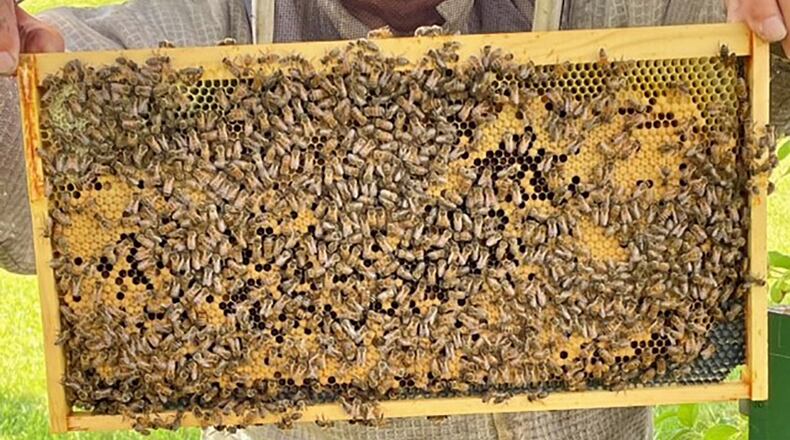On both Sandhill Road and Huffman Prairie, beehives are surrounded by a colorful array of wildflowers, where each colony consists of 30,000 to 80,000 honeybees. Wright-Patt has three bee yards with 16 separate colonies of beehives.
“While our honeybee program is certainly unique to the Department of Defense, the real benefits of it reach far beyond the honeybees,” said Danielle Trevino, a biological scientist with the 88th Civil Engineer Group’s Environmental Branch. “We’ve seen an increase in biodiversity of native plants and pollinators over the past several years. This is in large part due to the collaborative work being done with the honeybees on base.”
With the help of many important partners, 88 CEG has seen its pollinator program grow in recent years. The National Park Service and Five Rivers MetroParks are just a couple of the local organizations that work with Propolis Projects to help sustain and protect pollinator populations, both on the installation and in local communities.
It all started in 2014 with Karen Levin, executive director of the Levin Foundation, when her son noticed honeybee habitats were in trouble across Ohio and the Midwest. She decided to create Propolis Projects under the foundation’s umbrella.
The project unified various partners with experts such as Darryn Warner, 88 CEG’s Natural Resources program manager; David Nolan, retired director of conservation for Five Rivers MetroParks; and Dwight Wells, a retired General Motors engineer who is now Wright-Patt’s volunteer beekeeper. That helped Propolis grow and flourish.
“The word ‘propolis’ means glue,” Wells said. “Honeybees take resin off trees such as blue spruces and many hardwoods. Propolis acts as an antifungal, which aids in wound healing. Holes and cracks under three-eighths of an inch in the beehives are plugged by the honeybees.
“Honeybees build nests inside tree cavities and under edges of objects to hide themselves from predators.”
As a Bee City USA community, Wright-Patterson AFB works to provide healthy native habitats to sustain local honeybees and native pollinators. A quick stroll on the maintained trail through Huffman Prairie showcases that work.
Throughout growing season, visitors can find a plethora of pollinators, including hummingbirds, honeybees and bumblebees. Together, they create a sustainable and diverse habitat here on base.
There are more than 500 different types of native bees in Ohio, which need to be protected because honeybees pollinate over 65% of food crops, Wells said. Honeybees in the state come from eight different races of bees brought into the United States between 1622 and 1922.
He said honeybees face four major issues that threaten their long-term survival: pesticides, pathogens, parasites and poor nutrition. With Wright-Patt being over 8,000 acres and relatively isolated, the gene pool is very good.
No one is allowed to bring other honeybees onto the installation, he added.
Wells said he’s very passionate about his work with honeybees and doing everything possible to maintain and enlarge the base’s colony populations. Testing will be done again in 2022 by the Department of Agriculture to ensure there are no viruses or parasites adversely affecting them.
“It’s just this simple: Our lives depend on honeybees to pollinate crops,” he said.
For more information, contact Danielle Trevino at danielle.trevino.1@us.af.mil or Dwight Wells at dwells85@woh.rr.com.
About the Author


